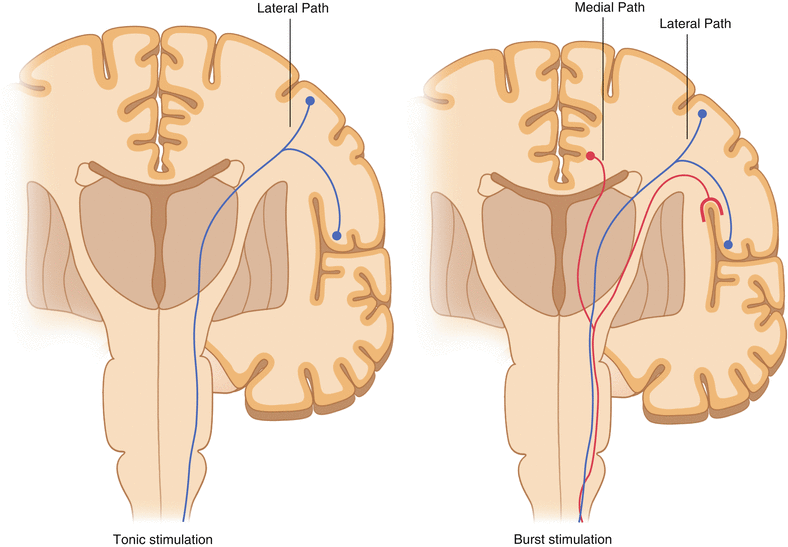Fig. 25.1
Stimulation strategies: tonic stimulation 40 Hz (a); burst stimulation (b)
It is important to briefly comment on the mechanism of action, as Burst-SCS appears to work differently than tSCS. It is hypothesized that burst-SCS works by stimulating not only the lateral pathway typically activated in tSCS but also the medial pathway, responsible for the affective component of pain. This may have implications in reducing the overall pain perception, which has been reported both anecdotally and in literature (Fig. 25.2).


Fig. 25.2
The activation of the lateral pathway in tSCS and activation of the lateral (a) and the medial (b) pathway in Burst-SCS (courtesy of St. Jude Medical, Plano TX)
It is important to note that although the Burst-SCS creates analgesia without the need for the perceived paresthesia, it requires placement within the epidural space in the same anatomic location as tSCS, namely relying on placement based on the Barolo mapping.
There is robust literature supporting Burst-SCS (Table 25.1).
Table 25.1
Burst stimulation studies to date
Study | Participants | Conclusion(s) | Complications |
|---|---|---|---|
de Vos et al. (2013) | 48 patients with existing tSCS for 6 months, with PDN, FBSS, and FBSS-PR; underwent B-SCS for 2 weeks | 60 % had better relief with Burst-SCS vs tSCS | None reported |
De Ridder et al. (2013) | 15 consecutive patients with limb and axial back pain; given Burst-SCS, tSCS, and placebo | Burst-SCS was better than tSCS or placebo in the treatment of back and leg pain | None reported |
De Ridder et al. (2010) | 12 patients with tSCS with paddle to treat neuropathic pain; given Burst-SCS | Burst-SCS may be better than tSCS in the treatment of neuropathic pain | None reported |
The double-blind, placebo-controlled trial performed by DeRidder et al. described that Burst-SCS improved back, limb, and general pain compared to tonic or placebo. de Vos et al. described patients with typically poorly treated patient populations, including diabetic peripheral neuropathy (DPN), failed back surgery syndrome, and failed back surgery syndrome, that were poor responders to tSCS (FBSS-PR). Although Burst-SCS improved pain care in all populations studied compared to tSCS, the effect was greatest for PDN and lesser for FBSS-PR.

Full access? Get Clinical Tree








